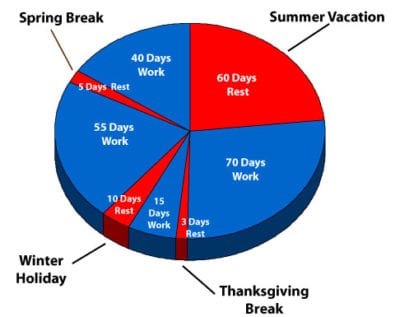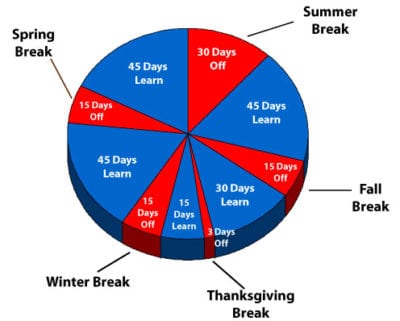Does the school calendar in the United States need an overhaul? Some say it does, especially in light of the COVID-19 pandemic. Teachers, parents, and students were left scrambling to figure out how to end the last school year (with most relying on distance learning) and then fell into the seemingly never-ending summer months. It’s no wonder that many have begun weighing the pros and cons of year-round schooling.
Do kids attend school for more days on a year-round plan?
When people hear “year-round schooling,” they often assume that it means kids will be in classrooms for 12 solid months. In reality, the number of school days would still be right around 180, just like it is with traditional calendars. Instead of a huge summer vacation, though, students and teachers would have a series of smaller breaks throughout the year.
At least 3,000 schools in the country have already adopted a year-round schooling schedule. This article on The School Superintendents Association website provides a truly eye-opening and fascinating look at some of the successes and challenges.
Traditional Schooling Calendar
Originally designed to allow children to help harvest crops with their families in the summer, the traditional schooling schedule made sense when the United States was more of an agricultural society. Today, very few families depend on this model.
- Operates on a 10-month system.
- Students spend 180 days in the classroom.
- Time off for major holidays
Year-Round Schooling Calendar
In other parts of the world, students attend year-round schooling. For example, the academic school year runs from April through March in Japan. In Australia, it runs from late January to mid-December.
- Students spend 180 days in the classroom.
- Using a 45-15 plan (45 days of class followed by a 15-day break) is common.
- Alternate schedules include 60-20 and 90-30 day plans.
- Time off for major holidays remains unchanged.
Here’s a quick visual representation of the differences between traditional and year-round school schedules.

Traditional School Year Calendar

Year-Round Schooling Calendar
Image credit: National Association of Year-Round Education (NAYRE).
Now that we know what year-round schooling could look like, let’s take a closer look at some of the potential advantages and disadvantages.
Pros of Year-Round Schooling
Proponents of year-round schooling tend to believe that this type of schedule helps students remember what they learn. It may prevent learning loss and provide more opportunities to build strong relationships with teachers and peers.
- Retention: By removing the interruption of a long summer break, students may be less likely to lose the skills they’ve been gaining.
- Remediation: Can occur when needed, as needed during the actual school year.
- Efficiency: School buildings and learning materials won’t go unused for months at a time and could result in fewer wasted resources.
- Regular Breaks: Having time off every two to three months allows teachers, students, and administrators some time to recharge and recalibrate throughout the year.
- Child Care: Parents often need to find someone to supervise children for an entire summer. Now, they could find more flexible solutions to their child care needs.
- Physical Activity: Long summers often mean watching television, playing video games, or scrolling through devices. Now, students will remain physically active throughout the year.
- More Travel Options: Families won’t have to restrict their vacation plans to holidays or summertime.
- Multitracking: Allows schools to accommodate more students and reduce overcrowding. See these examples on the NAYRE and California Department of Education websites.
Cons of Year-Round Schooling
Opponents of year-round schooling tend to suggest that there’s no real advantage to changing the schedule, as students are just as likely to forget what they’ve learned over a three-week break as they are over several months.
- Lack of Research: Detractors argue that there is not sufficient evidence that year-round schooling provides academic benefits.
- More Review: Most teachers do a student review at the beginning of the school year. Now they might have to do it four times to catch students up after breaks.
- Hot Classrooms: Many schools may lack the air conditioning systems needed to comfortably hold classes during the summer months.
- Child Care: Frequent breaks in the school schedule might make it more challenging for parents to secure supervision for their children.
- Youth Camps: Kids who look forward to summer camp could miss out on those experiences.
- Extracurricular Activities: From athletics to the arts, schools would need to find ways to schedule practices, competitions, and training in a totally different way.
- Summer Jobs: It would become very difficult, if not impossible, for older kids to get a summer job with a year-round schooling calendar.
- Teacher Jobs: In the same vein, many teachers work part-time over the summer.
- Multitracking: Parents could end up having kids at the same school but on different schedules.
- Missing Summer: We’ve grown used to that long summer break, and some would be sad to give that up..
Change to any established schedule can be hard, but sometimes the difficulty is worth it. Year-round schooling might create new challenges for some families. The current schedule also creates problems—we’ve just gotten used to them! Could the advantages of year-round schooling outweigh the disadvantages? It’s a question worth asking.
What are your thoughts on year-round schooling? Please share in the comments!
Plus, read why More Parents are Considering Established Online Schools. Are we moving towards a different calendar entirely?


